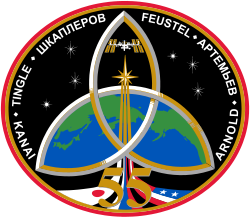Expedition 56
| Expedition 56 | |||
 | |||
| Uppdragsstatistik | |||
|---|---|---|---|
| Rymdstation: | ISS | ||
| Start: | 3 juni 2018[1] | ||
| Slut: | 4 oktober 2018 | ||
| Antal besättningsmedlemmar: | 6 st | ||
| Rymdpromenad | |||
| Antal rymdpromenader: | 2 st | ||
| Total tid: | 14 tim, 35 min | ||
| Transport | |||
| Uppskjutning: | med Sojuz MS-08, Sojuz MS-09 | ||
| Uppskjutningsplats: | Kosmodromen i Bajkonur | ||
| Landning: | med Sojuz MS-08, Sojuz MS-09 | ||
| Landningsplats: | Kazakstan | ||
| Kronologi | |||
| |||

Expedition 56 var den 56:e expeditionen till Internationella rymdstationen (ISS). Expeditionen började den 3 juni 2018 då delar av Expedition 55s besättning återvände till jorden med Sojuz MS-07.
Alexander Gerst, Serena Auñón-Chancellor och Sergey Prokopyev anlände till stationen med Sojuz MS-09 den 8 juni.
Expeditionen avslutades den 4 oktober 2018, då Oleg Artemyev, Andrew J. Feustel och Richard R. Arnold återvände till jorden med Sojuz MS-08.
Besättning
| Position | Första delen (3 - 8 juni 2018) | Andra delen (8 juni - 4 oktober 2018) |
|---|---|---|
| Befälhavare | Hans tredje rymdfärd | |
| Flygingenjör 1 | Hans andra rymdfärd | |
| Flygingenjör 2 | Hans andra rymdfärd | |
| Flygingenjör 3 | Hans andra rymdfärd | |
| Flygingenjör 4 | Hennes första rymdfärd | |
| Flygingenjör 5 | Hans första rymdfärd | |
Referenser
- ^ NASA's Space Station Expedition 56 Arkiverad 31 augusti 2018 hämtat från the Wayback Machine., läst 3 juni 2018.
Externa länkar
| |||||||||||||||||||
Media som används på denna webbplats
The official insignia of the three-member Expedition 57 crew
- Humans are explorers. We live on a cosmic island. Setting sails towards new worlds has always been our nature, and it is key to our survival. As soon as our ancestors learned how to build ships, they not only used them to sail up and down the coasts, but ultimately they set out to travel beyond the horizon, to discover new continents. The time of space exploration has just begun, a mere blink of an eye in the eon-long history of human exploration. And yet we already have successfully built great ships to sail the black heavenly seas, and we have dared adventurous journeys into the unknown.
- The Expedition 57 patch is a tribute to human exploration. It depicts an explorer's ship leaving for the unknown as our early ancestors did, and is shaped like an arrow, heading out to new cosmic horizons. It highlights the purpose of the International Space Station as a world class science laboratory for the benefit of mankind and international cooperation, as well as humanity's flagship in space, preparing us for the amazing voyages ahead.
- The Expedition 57 patch is dedicated to all those thousands of humans who make this journey possible through the contribution of their passion, hard work, and courage to one of the most fascinating projects in human history.
The official portrait of the Expedition 56 crew. In the front row from left are astronauts Drew Feustel of NASA and Alexander Gerst of the European Space Agency. In the rear from left are crew members Oleg Artemyev of Roscosmos, Ricky Arnold of NASA, Sergei Prokopev of Roscosmos and Serena Auñón-Chancellor of NASA.
The Expedition 56 crew insignia
- The Expedition 56 astronaut crew will continue the international collaborative work that has been evolving on the International Space Station during the past 17 years. The expedition comes at a time when private corporations and the governments around the world are rapidly developing crew capabilities for human space exploration. Together, with the experience and continued research on the orbiting laboratory, humans will soon establish a new presence in space beyond low-Earth orbit that will enable us to travel farther into space than ever before.
- The Expedition 56 patch portrays a dove carrying an olive branch on its beak. The patch includes images of the Soyuz launch vehicle for the crew and the space station. The Expedition 56 astronauts’ names are displayed on the dove’s wings and along the limb of Earth at the base of the patch.
- The dove's tail is firmly planted on Earth to represent the strong link between our home planet and the humans who are sent into the cosmos. The patch illustrates our hope for peace and love in the world, and the innate human desire to spread our wings and explore into the future, building on the wisdom of the past, for the betterment of humanity. The patch was designed by astronaut Drew Feustel's son.
The official mission insignia of the Expedition 55 crew.
- The six crew members of Expedition 55 are patriots from three different countries – Japan, Russia, and the United States. The crew from these three countries will work together to ensure the success of Expedition 55.
- The three rings symbolize the three countries of the six crew members. The rings join in a common intersection, symbolizing collaboration and a common focus for the crew aboard the space station. The colors of the rings represent the energy and power required to carry humans and equipment into space and to operate the ISS. The colors blue and green represent the magnificent beauty of Earth. The color black represents the darkness of space, and the immense challenge of exploring space. The six stars represent the crew, Norishige Kanai, Scott Tingle, Anton Shkaplerov, A.J. (Drew) Feustel, Oleg Artemyev, and Ricky Arnold. The three flags are the flags representing each crew member’s country. The swoosh extending upward towards space represents the dedication of cosmonauts, astronauts and a multinational support team working together to explore space and discover new science that will benefit all humans.






